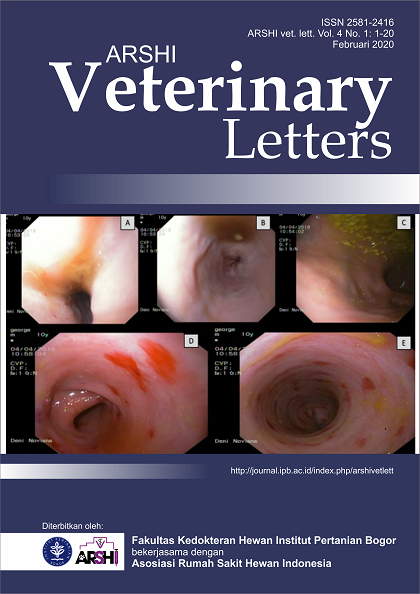Gambaran kepekaan Escherichia coli dari peternakan ayam broiler di Desa Bojongkerta Kabupaten Sukabumi terhadap antibiotik
Abstract
Masalah resistensi Escherichia coli (E. coli) terhadap antibiotik telah banyak dilaporkan. Peningkatan kasus resistensi bakteri terhadap antibiotik dapat dilihat dari banyaknya laporan bahwa terdapat antibiotik yang sudah tidak efektif lagi terhadap suatu bakteri patogen. Pola penggunaan antibiotik di Indonesia dan negara-negara lain semakin meningkat dan banyak diantaranya masih digunakan secara tidak tepat. Tujuan penelitian ini adalah mempelajari gambaran kepekaan E. coli dari ayam broiler terhadap sefpodoksim, sefoksitin, sulfametoksazol-trimetoprim, kolistin sulfat, seftizoksim, aztreonam, dan nitrofurantoin dari peternakan ayam broiler di Desa Bojongkerta Kabupaten Sukabumi Jawa Barat. Pengujian resistensi antibiotik menggunakan metode difusi cakram menurut Kirby-Bauer. Hasil uji kepekaan isolat E. coli menunjukkan bahwa isolat E.coli dalam penelitian ini telah resisten terhadap sefpodoksim, sefoksitin, sulfametoksazol-trimetoprim, seftizoksim, aztreonam, dan nitrofurantoin. Namun tidak menunjukkan hasil terhadap kolistin sulfat.
Downloads
References
[CLSI] Clinical and Laboratory Standards Institute. 2018. Performance standards for antimicrobial susceptibility testing. Wayne (US): Clinical and Laboratory Standards Institute.
Bahri S, Masbulan E, Kusumaningsih A. 2005. Proses praproduksi sebagai faktor penting dalam menghasilkan produk ternak yang aman untuk manusia. Jurnal Litbang Per-tanian. 24(1): 27-35.
Carattoli A. 2008. Animal reservoirs for extended spectrum β‐lactamase producers. Clinical Microbiology and Infection. 14: 117-123.
Erfianto GI. 2014. Escherichia coli yang resisten terhadap antibiotik yang diisolasi dari sapi potong yang diimpor melalui pelabuhan Tanjung Priok Jakarta [Tesis]. Bogor (ID): Institut Pertanian Bogor.
Gales AC, Reis AO, Jones RN. 2001. Contemporary assessment of antimicrobial susceptibility testing methods for polymyxin B and colistin: review of available interpretative criteria and quality control guidelines. Journal of clinical microbiology. 39(1): 183-190.
Markey B, Leonard F, Archambault M, Cullinane A, Maguire D. 2013. Clinical Veterinary Microbiology. 2nd Ed. London (UK): Mosby Elsevier.
Noviana H. 2004. Pola kepekaan antibiotika Escherichia coli yangdiisolasi dari berbagai spesimen klinis. Jurnal Kedokteran Trisakti. 23(4): 122-126.
Refdanita MR, Nurgani A, Endang P. 2004. Pola kepekaan kuman terhadap antibiotika di ruang rawat intensif Rumah Sakit Fatmawati Jakarta tahun 2001–2002. Makara, Kesehatan. 8(2): 41-48.
Sandegren L, Lindqvist A, Kahlmeter G, Andersson DI. 2008. Nitrofurantoin resistance mechanism and fitness cost in Escherichia coli. Journal of Antimicrobial Chemotherapy. 62(3): 495-503.
Silbergeld EK, Graham J, Price LB. 2008. Industrial food animal production, antimicrobial resistance, and human health. Annu. Rev. Public Health. 29: 151-169.
Tan TY, Ng LS. 2006. Comparison of three standardized disc susceptibility testing methods for colistin. Journal of Antimicrobial Chemotherapy. 58(4): 864-867.
Copyright (c) 2020 CC-BY-SA

This work is licensed under a Creative Commons Attribution-ShareAlike 4.0 International License.
Authors who publish with this journal agree to the following terms:
1. Authors retain copyright and grant the journal right of first publication with the work simultaneously licensed under a Creative Commons Attribution License that allows others to share the work with an acknowledgement of the work's authorship and initial publication in this journal.
2. Authors are able to enter into separate, additional contractual arrangements for the non-exclusive distribution of the journal's published version of the work (e.g., post it to an institutional repository or publish it in a book), with an acknowledgement of its initial publication in this journal.
3. Authors are permitted and encouraged to post their work online (e.g., in institutional repositories or on their website) prior to and during the submission process, as it can lead to productive exchanges, as well as earlier and greater citation of published work (See The Effect of Open Access).


.jpg)















